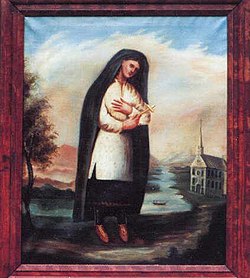 When a friend of Flannery O'Connor's complained of sexism in theCatholic Church in the 1950s, the novelist dismissed the accusation, pointingout that "the Church would just as soon canonize a woman as aman." A keen observer ofCatholicism, O'Connor was uncharacteristically off the mark in this instance,as women make up only about one-fourth of the Church's canonized saints. Thismakes yesterday's announcement all the more remarkable: in authenticating asecond miracle for Kateri Tekakwitha and for Mother Marianne Cope, PopeBenedict has essentially added two more female U.S. saints to the Catholiccanon (a papal bull of canonization will almost certainly be forthcoming, mostlikely within a year). At present thereare nine canonized saints who lived in the United States or territory thatlater became part of the United States; five of them are women. The imminentaddition of Tekakwitha and Cope tilts the balance of power heavily in women'sfavor, a phenomenon not often witnessed in Catholic circles.
When a friend of Flannery O'Connor's complained of sexism in theCatholic Church in the 1950s, the novelist dismissed the accusation, pointingout that "the Church would just as soon canonize a woman as aman." A keen observer ofCatholicism, O'Connor was uncharacteristically off the mark in this instance,as women make up only about one-fourth of the Church's canonized saints. Thismakes yesterday's announcement all the more remarkable: in authenticating asecond miracle for Kateri Tekakwitha and for Mother Marianne Cope, PopeBenedict has essentially added two more female U.S. saints to the Catholiccanon (a papal bull of canonization will almost certainly be forthcoming, mostlikely within a year). At present thereare nine canonized saints who lived in the United States or territory thatlater became part of the United States; five of them are women. The imminentaddition of Tekakwitha and Cope tilts the balance of power heavily in women'sfavor, a phenomenon not often witnessed in Catholic circles. As Linford Fisherdiscussed in this space Monday, Tekakwitha has long been considered a patronsaint of Native Americans and will be the first of their number canonized bythe Catholic Church. She will also be the first American saint who was not amember of a religious community. In thisrespect American saints do correspond with universal patterns. Men and women religious are overrepresented in thecanon of the saints for good reason; religious congregations have thepersonnel, the funding and the institutional memory to sustain a cause forcanonization through the decades or even centuries it takes for a cause tosucceed.
U.S. Catholicsbegan lobbying for a saint of their own in the 1880s. Half a century later, the Catholic Churchcanonized the North American martyrs, eight Jesuit missionaries who were killedin New France in the seventeenth century. Two of those had died in territorythat later became part of upstate New York, and thus they technically countedas U.S. saints. But most American Catholics held off from celebrating until1946, when Frances Cabrini became the first U.S. citizen to be canonized. Thefirst native-born saint, Elizabeth Ann Seton, was canonized in 1975, followedtwo years later by the the canonization of John Neumann, a Bohemian-bornRedemptorist missionary and bishop of Philadelphia. Since then pace ofcanonizations has increased dramatically, with the canonization of Mother RosePhilippine Duchesne (1988) Mother Katharine Drexel (2000), Mother TheodoreGuerin (2006) and Father Damien de Veuster (2009), who like Marianne Cope,served a leper community in Molokai.
We can expect thatTekakwitha and Cope represent the beginning of an even more dramatic uptick inthe total number of American saints. There are over fifty American causes atvarious stages in the process, and many of them made significant progressduring the pontificate of John Paul II. He canonized more people than all of his predecessors combined, in partby streamlining the complicated process. John Paul II was in particularcommitted to canonizing people from among national and ethnic groups that werewithout patron saints. This explains, in part, his decision to waive therequired miracle for Kateri Tekakwitha, which paved the way for her 1980beatification. John Paul II also made a concerted effort to canonize more laypeople. And while he is not oftenregarded as a hero to Catholic feminists, it is worth pointing out that roughlyone-third of the 482 saints he canonized were women, lending, belatedly and perhapsfleetingly, a certain credence to Flannery O'Connor's observation.